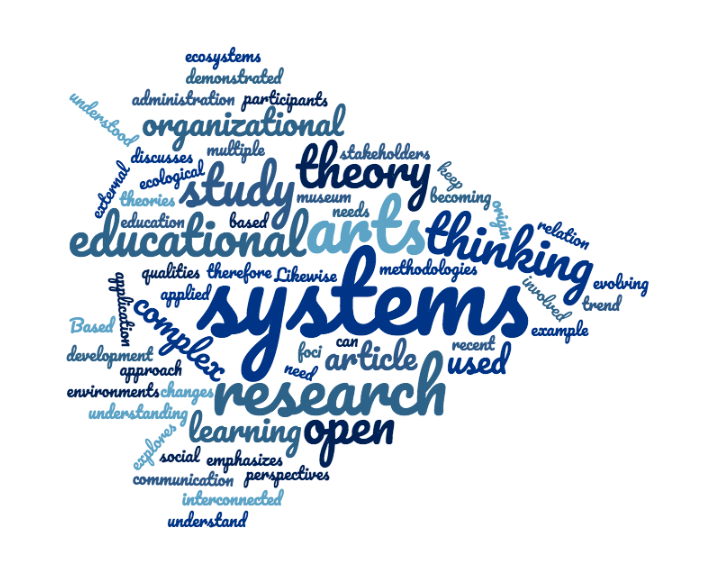Systems Thinking in Organizations: Applying It to Study Arts and Educational Settings
Keywords:
systems thinking, mechanical thinking, organizational theories, communication theories, museums, ecological research approachAbstract
This article discusses the origin and development of systems thinking used in organizational and communication theories in understanding organizational systems. While application of systems thinking in arts administration and education is a recent trend, the article explores how this theory is used to understand and study arts and educational organizations. Based on this theory, arts and educational organizations are understood as open, complex systems that are social ecosystems themselves but are interconnected to external environments. These open systems need to keep evolving and learning as organizations in relation to changes and needs of the stakeholders, therefore becoming learning organizations. Likewise, this theory can be applied to research methodologies to study arts and educational organizations, as demonstrated by a museum research example. This ecological research approach based on systems thinking emphasizes the open, complex qualities of research foci and multiple perspectives of the involved participants of the study.
References
Ackoff, R. L., Addison, H. J., & Carey, A. (2010). Systems thinking for curious managers: With 40 new management F-laws. Devon, United Kingdom: Triarchy Press.
Jung, Y. (2011). The art museum ecosystem: A new alternative model. Museum Management and Curatorship, 26(4), 321-338.
Jung, Y. (2012). Building strong bridges between the museum and its community: An ethnographic understanding of the culture and systems of one community’s art museum (Unpublished doctoral dissertation). Pennsylvania State University, University Park.
Jung, Y. (2014a). Building strong bridges between the museum and its community: An ethnographic understanding of the culture and systems of one community’s art museum. The International Journal of the Inclusive Museum, 6(3), 1-11.
Jung, Y. (2014b). Mindful walking: The serendipitous journey of community-based ethnography. Qualitative Inquiry, 20(5), 621-627.
Bateson, G. (2000). Steps to an ecology of mind. Chicago, IL: University of Chicago Press.
Capra, F. (1996). The web of life: A new scientific understanding of living systems. New York, NY: Anchor Books.
Daft, R. L. (2013). Organization theory & design. Mason, OH: South-Western.
Flood, R. L. (2010). The relationship of ‘systems thinking’ to action research. Systemic Practice and Action Research, 23(4), 269-284.
Gharajedaghi, J. (2011). Systems thinking: Managing chaos and complexity: A platform for designing business architecture. Burlington, MA: Morgan Kaufmann.
Handy, C. (1993). Understanding organizations: How understanding the ways organizations actually work can be used to manage them better. New York, NY: Oxford University Press.
Ingold, T. (2007). Lines: A brief history. London, United Kingdom: Routledge.
Janes, R. R. (2009). Museums in a troubled world: Renewal, irrelevance or collapse? Abingdon, United Kingdom and New York, NY: Routledge.
Leland, C. H., & Kasten, W. C. (2002). Literacy education for the 21st century: It’s time to close the factory. Reading & Writing Quarterly, 18(1), 5-15.
McGregor, D. (1960). The human side of enterprise. New York, NY: McGraw-Hill.
Moore, K. (1994). Introduction: Museum management. In K. Moore (Ed.), Museum management (pp. 1–14). London, United Kingdom: Routledge.
Nespor, J. (1997). Tangled up in school: Politics, space, bodies, and signs in the educational process. Mahwah, NJ: Laurence Erlbaum Associates, Inc.
Parker, S. (2012). Building arts organizations that build audiences. Wallace Foundation. Retrieved from http://www.wallacefoundation.org/knowledge-center/Documents/Building-Arts-Organizations-That-Build-Audiences.pdf
Peters, T. J., & Waterman, R. H. (1982). In search of excellence: Lessons from American’s best-run companies. New York, NY: Warner Books.
Robinson, K. (2010). Ken Robinson: Changing educational paradigms. Video.
Roethlisberger, F. J. (1968). Man-in-organization: Essays of F. J.
Roethlisberger. Cambridge, MA: Harvard University Press.
Seddon, J. (2008). Systems thinking in the public sector: The failure of the reform regime and a manifesto for a better way. Axminster, United Kingdom: Triarchy Press.
Senge, P. M. (2006). The fifth discipline: The art and practice of the learning organization. New York, NY: Doubleday.
Simon, H. A. (1997). Administrative behavior: A study of decision-making processes in administrative organizations. New York, NY: The Free Press.
Taylor, F. W. (1911). The principle of scientific management. Mineola, NY: Dover Publications.
Von Bertalanffy, L. (1933). Modern theories of development: An introduction to theoretical biology. Oxford, United Kingdom: Oxford University Press.
Von Bertalanffy, L. (1950). The theory of open systems in Physics and Biology. Science, 111, 23-29.
Von Bertalanffy, L. (1972). The history and status of general systems theory. The Academy of Management Journal, 15(4), 23-29.
Weber, M. (1964). The theory of social and economic organization. New York, NY: The Free Press.
Werhane, P. H. (2002). Moral imagination and systems thinking. Journal of Business Ethics, 38(1/2), 33-42.

Downloads
Additional Files
Published
Issue
Section
License
Authors who publish with this journal agree to the following terms:- Authors retain copyright and grant the journal right of first publication with the work simultaneously licensed under a Creative Commons Attribution License that allows others to share the work with an acknowledgement of the work's authorship and initial publication in this journal.
- Authors are able to enter into separate, additional contractual arrangements for the non-exclusive distribution of the journal's published version of the work (e.g., post it to an institutional repository or publish it in a book), with an acknowledgement of its initial publication in this journal.
- Authors are permitted and encouraged to post their work online (e.g., in institutional repositories or on their website) prior to and during the submission process, as it can lead to productive exchanges, as well as earlier and greater citation of published work (See The Effect of Open Access).

